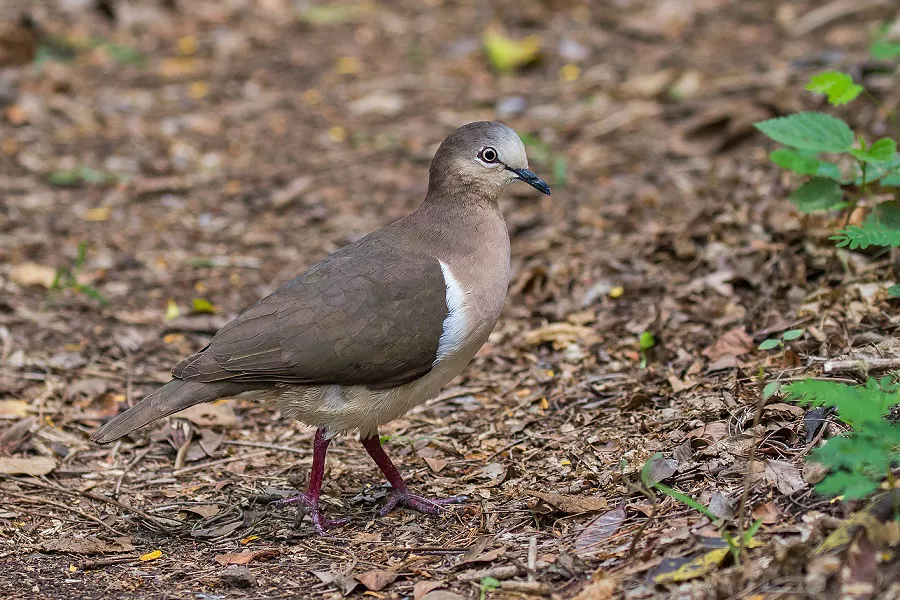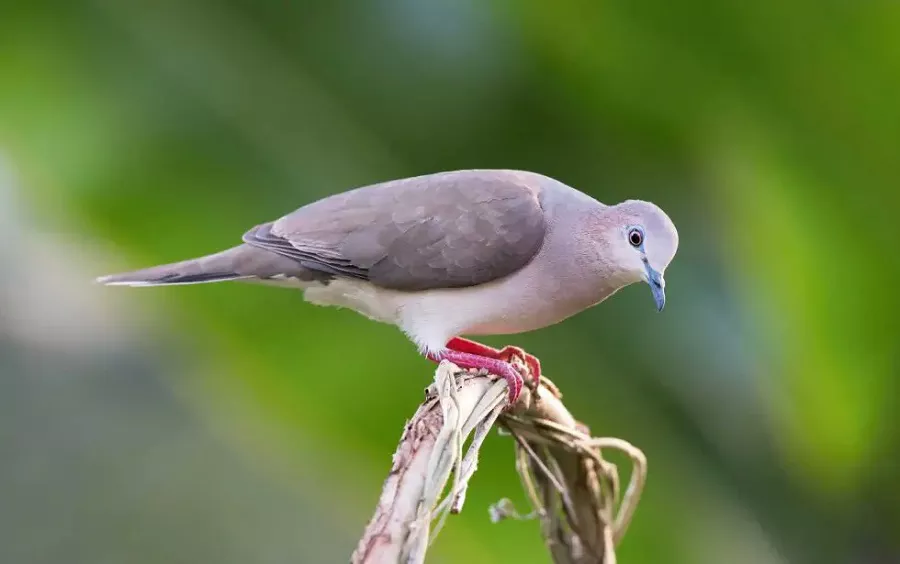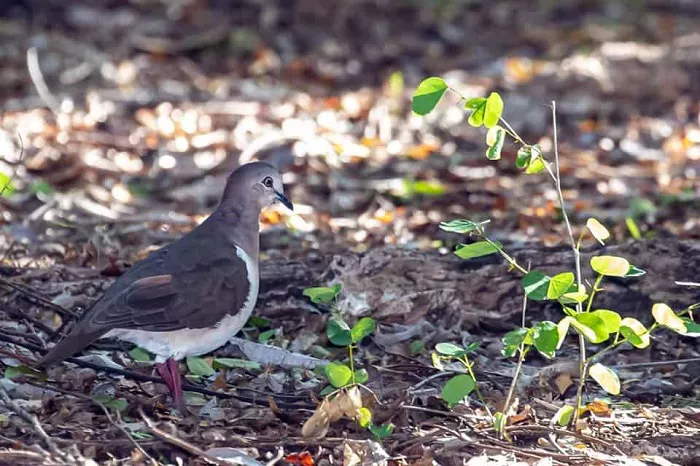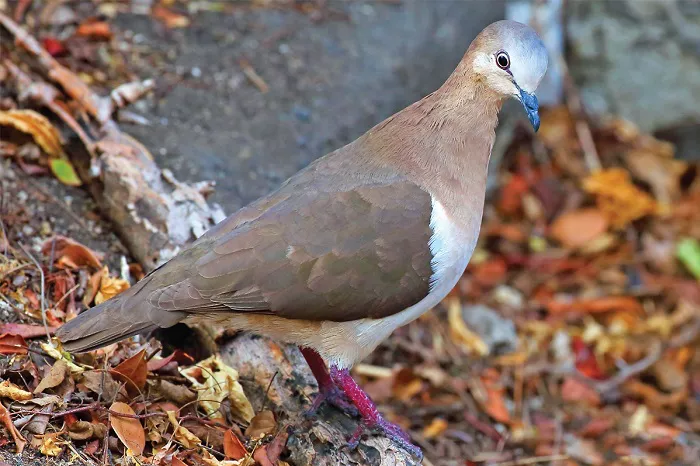The Grenada Dove (Leptotila wellsi), is found only on Grenada. Originally known as the Pea Dove or Well’s Dove, it is the National Bird of Grenada. It is considered to be one of the most critically endangered doves in the world (Birdlife International 2000). It is also Endangered endemic birds of Grenada, West Indies. Bird Conservation International 1: 83-91. The Grenada Dove is listed as critically endangered by BirdLife International on the IUCN Red List, underscoring the urgent need for its conservation.
In this article, we delve into the significance of the critically endangered Grenada Dove, exploring its characteristics, habitat, conservation status, cultural importance, and ways to support its preservation.
Physical Description
The Grenada dove is a sight to behold, characterized by its elegant appearance and soft features. It measures approximately 31 centimeters in length, with a distinctively plump body and a slender neck. The Grenada Dove is characterised by a white throat; face and forehead pale pink shading to dull brown on crown and nape; upperparts olive brown; underwing chestnut; neck and upper breast pink-buff fading to white on lower breast, belly and undertail coverts.
Grenada Dove Habitat and Distribution
The Grenada Dove (Leptotila wellsi) is a critically endangered bird species endemic to the island of Grenada in the Caribbean. The Grenada Dove is one of the flagship species for conservation efforts in Grenada, symbolizing the importance of preserving the island’s unique biodiversity. The dove is found in dry forest communities, particularly along the west coast of the island. Here’s an overview of its habitat and distribution:
Habitat
The Grenada Dove primarily inhabits dry, deciduous forests and scrublands. It prefers areas with dense understory vegetation, which provides cover and nesting sites. These habitats are typically found in lowland areas and coastal dry forests. The dove is highly dependent on undisturbed forested areas, as it avoids open or heavily altered landscapes. However, most areas classified as dry forest in the Caribbean are mosaics of degraded habitat rather than natural ecosystems, reflecting remnants of xeric scrub habitat and altered natural forest communities. The Grenada Dove relies on three seasonal forest formations: semi-evergreen forest, deciduous seasonal forest, and thorn woodlands.
Distribution
The Grenada Dove is restricted to the island of Grenada, and its population is fragmented into a few small, isolated areas. Specific locations where Grenada doves occur include various watersheds and sanctuaries designated for their protection. The two main strongholds for the species are:
- Mt. Hartman National Park: Located in the parish of St. George’s in southwestern Grenada, this area is a critical habitat for the dove.
- Perseverance Sanctuary: Located on the western Caribbean coast, it is the second roosting site for the Grenada pigeon population.
Due to habitat loss from deforestation, agriculture, and urban development, the Grenada Dove’s range has significantly diminished, and grenada dove population is estimated to be fewer than 160 individuals in the wild.
Conservation efforts are ongoing to protect and restore its habitat, including the establishment of protected areas and reforestation initiatives.
Conservation Status
The Grenada Dove is classified as critically endangered by the International Union for Conservation of Nature (IUCN), highlighting the urgent need for conservation action. Habitat destruction, caused by deforestation and urban development, poses a significant threat to the bird’s survival. Additionally, the introduction of invasive species such as mongooses and rats exacerbates predation pressure on the Grenada Dove population.
To address these challenges, conservation initiatives focus on habitat restoration, community engagement, and scientific research to better understand the dove’s ecology and behavior. By fostering partnerships between government agencies, non-profit organizations, and local communities, Grenada is striving to ensure a brighter future for its national bird and preserve its natural heritage for generations to come.
Cultural and Symbolic Importance
Beyond its biological significance, the Grenada Dove carries profound cultural and symbolic importance for the people of Grenada. Revered as a symbol of peace and resilience, the dove embodies the spirit of unity and harmony amidst diversity. Its presence in Grenada’s emblem reflects the nation’s aspirations for prosperity and tranquility.
Cultural Connection
Grenada’s folklore and traditions are deeply intertwined with the Grenada Dove. Legend has it that the dove is a guardian spirit, watching over the island and its inhabitants. Its soothing coo is believed to bring blessings and protection to those who hear it, a sentiment echoed in Grenadian folk songs and stories passed down through generations.
In Grenadian art and literature, the Grenada Dove often serves as a muse, inspiring poets, painters, and musicians alike. Its graceful presence symbolizes hope and resilience in the face of adversity, a motif evident in various artistic expressions across the island.
Visiting and Observing
For avid birdwatchers and nature enthusiasts, witnessing the beauty of the Grenada dove in its natural habitat is a rare and unforgettable experience. While sightings may be challenging due to the bird’s elusive nature, visitors can increase their chances by exploring protected areas such as Mt. Hartman National Park and Perseverance Sanctuary.
It is essential to observe responsible tourism practices when seeking out the Grenada dove, respecting its habitat and maintaining a safe distance to minimize disturbance to these delicate creatures.
Some Interesting Facts About Grenada dove
The Grenada dove (Leptotila wellsi) is a critically endangered species of dove native to the island of Grenada in the Caribbean. Here are some interesting facts about this unique bird:
1. Endangered Status: The Grenada dove is one of the rarest doves in the world and is classified as critically endangered by the International Union for Conservation of Nature (IUCN). Its population has declined dramatically due to habitat loss and hunting.
2. Distinct Appearance: The Grenada dove is a beautiful bird with a unique appearance. It has a soft, pale gray plumage with a distinctive lilac wash on its head, neck, and breast. Its wings are marked with black and white spots, and it has bright red legs and feet.
3. Restricted Habitat: This species is endemic to Grenada, meaning it is found nowhere else in the world. It primarily inhabits the island’s dry forests and scrublands.
4. Mating Rituals: Grenada doves are known for their elaborate courtship displays. During mating season, males will perform a series of impressive aerial acrobatics, including steep dives and sharp turns, to attract females. Only one active Grenada dove nest has been documented, highlighting the importance of understanding their nesting habitat and patterns for conservation efforts.
5. Low Reproductive Rate: Like many other doves, Grenada doves have a relatively low reproductive rate. They typically lay only one egg per nesting attempt, and the incubation period lasts around two weeks. Observations have noted Grenada doves foraging mainly for food sources such as Carica papaya on the ground. Identifying and preserving suitable habitat is crucial for their conservation.
6. Conservation Efforts: The Mt. Hartman National Park was established by the Government of Grenada in 1996 to ensure the protection of the endemic Grenada Dove in one of the key habitats for the bird on the island. The National Park has been identified by BirdLife International as an Important Bird Area (IBA) for the Grenada Dove.
7. Symbol of Grenada: The Grenada dove holds cultural significance for the people of Grenada and is considered a national symbol. It is featured on the country’s coat of arms and is celebrated as a symbol of peace and environmental conservation.
8. Legal Protection: In Grenada, the Grenada dove is legally protected from hunting and trade under national laws. The conservation efforts for the Grenada Dove are often contrasted with those for other local dove species, such as the Common Ground Dove, highlighting the unique challenges faced by this critically endangered bird.
Conclusion
In conclusion, the Grenada dove stands as a symbol of pride, resilience, and natural beauty for the people of Grenada. As we navigate the challenges of environmental conservation in the 21st century, it is imperative that we come together to protect and preserve this iconic species. By recognizing the cultural, ecological, and symbolic significance of the Grenada dove, we can pave the way for a sustainable future where this majestic bird continues to grace the skies of Grenada for generations to come.
FAQs About Grenada dove
Why is the Grenada Dove endangered?
The Grenada Dove (Leptotila wellsi) is critically endangered primarily due to habitat loss. Rapid deforestation, land development for agriculture and tourism, and urban expansion have significantly reduced the dry coastal forests where the dove thrives. With fewer than 200 individuals remaining, this bird is one of the rarest doves in the world. Additionally, fragmentation of habitats makes it difficult for the species to reproduce and maintain a stable population.
What are the predators of the Grenada Dove?
Predators of the Grenada Dove include mongoose, feral cats, rats, and snakes. These invasive species pose a significant threat to the dove, especially to eggs and chicks. Nest predation by these animals has further contributed to the decline of an already vulnerable population.
What do the Grenada Doves eat?
Grenada Doves primarily feed on a variety of seeds, fruits, and berries found in their natural habitat. They also consume insects and small invertebrates, particularly during the breeding season, to supplement their diet with extra protein. The bird’s ground-foraging behavior makes it dependent on a healthy forest floor ecosystem.
What is the Grenada national flower?
The Bougainvillea is recognized as the national flower of Grenada. Known for its vibrant and colorful bracts—ranging from magenta to orange and purple—this flower is a symbol of beauty and resilience. Bougainvilleas are commonly found throughout the island and are appreciated for their ability to thrive in Grenada’s tropical climate.





 Facebook
Facebook  Instagram
Instagram  Youtube
Youtube 